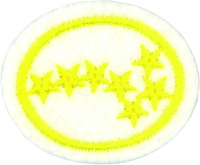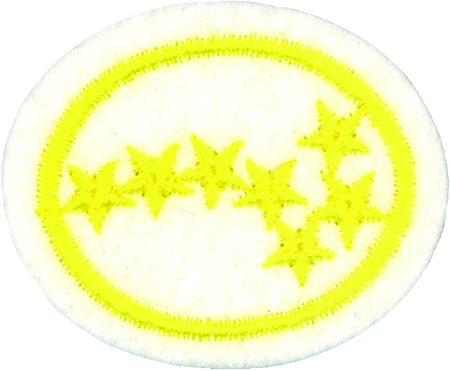AY Honor Stars Answer Key used by South Pacific Division
1
1a
The solar system is composed of gases, rocks, liquids, solid masses, and gas masses. Planets (some with satellites) move around the central star which we know as the Sun. Each planet requires a different amount of time to orbit the Sun. Each planet also has its own period of day due to different revolution speed. In between the orbits of certain planets are belts of asteroids (lots of rocks and gases).
1b
The Earth's nearest celestial neighbor is the Moon.
1c
2
2a
One may demonstrate by using an orange, walnut, and marble, or similar objects, to show positions and movements of the earth, sun, and moon when there is an eclipse of the sun and when there is an eclipse of the moon.
Place the "sun" model in the center. Place the "earth" some distance from the sun, and show how it travels in a near circle around the sun. The moon travels around the earth, but it always shows the same face to the earth (it's rotation on its axis takes the same amount of time as its orbit around the earth.
2b
The tides are governed by the Moon, and to a lesser extent, by the Sun. Spring tides are when the pull of the moon and sun is greatest and neap tides is when the pull is least.
2c
Lunar eclipse
[[image:Geometry of a Total Solar Eclipse.svg|300px|Solar eclipse]]Solar eclipse
An eclipse is caused when the Sun, Earth, and Moon are in a direct line with one another. When the Earth is between the Sun and the Moon, we see a lunar eclipse, which is the Earth's shadow falling on the moon. When the Moon is between the Sun and the Earth, we see a solar eclipse, which is when the Moon's shadow falls on the Earth (blocking the Sun).
2d
A shooting star is not a star at all, but rather a meteor. A meteor is any celestial body (usually quite small) that falls to the Earth. Most burn up in the atmosphere before reaching the surface, leaving a bright, short-lived streak in the sky.
2e
Comets are particles if ice that orbit the sun. These orbits are highly elliptical, meaning that they come closer to the Sun than Mercury and then move farther away from it than Neptune. As the comet's orbit takes it near the sun, the sun's energy breaks down the particles and drives gases and dust out away from the sun in a long glowing tail. Some comets take over one hundred years to complete an orbit.
3
Light travels 300,000 km every second.
4
4a
Which eight stars you choose to teach your Pathfinders to identify will depend on the season (spring, summer, winter, or autumn), although some stars are visible year-round.
Alpha Centauri, Beta Centauri (pointers in Southern cross), Canopus (Argo), Sirius (Canus Major), Aldebaran (Taurus), Castor, Pollux (Gemini), Rigel, Betelguse (Orion), Antares (Scorpio).
4b
The word planet means wanderer because the planets appear to wander about the sky relative to the stars. The fixed stars do not move in relation to one another (although they all appear to move together because of the Earth's rotation on its axis).
5
5a
A constellation is a pattern of stars that look grouped together. The ancient Greeks gave them names and made up myths about them. By naming constellations they made a map of the sky.
5b
Southern Cross or Crux Australus, Orion, Virgo, Centaur, Scorpio, False Cross, Canis Major, Leo
Part of the Southern Cross are on the following countries flags: Australia, Brazil, New Zealand , Niue , Papua New Guinea , Samoa , Tokelau
5c
Southern Cross, False Cross, Triangulum Australe, Apus, Centaurus, Musca, Diamond Cross.
6
A series of drawings show the movement of the night sky around the Southern Celestial pole (SCP).
7
It would be a good idea to find out when the sun will rise and then set an alarm so you can be awake when it happens. Many weather web sites also have almanac data to tell you when the sun will rise and set. An ideal time to do this would be on a campout. Watching the sunset can be an excellent vespers program.
8
8a
The Milky Way is the name of our galaxy. A galaxy is a disc of stars, and since the Earth and the rest of our Solar System are in that disc, the Milky Way appears as a faint strip in the sky. To view it properly, you will need a very dark sky.
8b
A large gathering of stars and bodies making up one of many galaxies. The portion visible in the night sky of Earth is only a single dimensional or flat view of the galaxy as our solar system is part of the same galaxy we have lack for a broader perspective.
9
9a
The morning star and evening star are one and the same body - the planet Venus.
9b
Because it is nearer to the Sun than the Earth is, it always appears in the sky near the Sun. This means it can only be seen either in the morning within a few hours of sunrise, or in the evening within a few hours of sunset. Venus is the third brightest object in the sky, after the Sun and the Moon, so it is fairly easy to spot. When it appears in the evening, it will always be in the West. When it appears in the morning, it will always be in the East. You may need to consult an almanac to know whether it will appear in the morning or in the evening.
10
The planets in our solar system, starting from the Sun, are Mercury, Venus, Earth, Mars, Jupiter, Saturn, Uranus, and Neptune. Pluto was also considered a planet from 1930 until 2006 when the International Astronomer's Union (IAU) was prompted by the discovery Eris, a body slightly smaller than Pluto, to come up with a formal definition of the word "planet." For years leading up to this announcement there had been rumblings in the scientific community that classifying Pluto as a planet had been a mistake, much as the classification of Ceres, the largest asteroid had been a mistake in the 1800's. After the discovery of Ceres, more and more asteroids were discovered, and it became increasingly clear that it was not a planet. The same thing began to happen in the late 1990's when astronomers began to discover several Pluto-like objects in the Kuiper belt. The debate came to a head with the discovery of Eris, which has more mass than Pluto, but is very slightly smaller. The IAU would have to either recognize Eris as the tenth planet or "demote" Pluto. The demotion of Pluto, though not popular with the general public, makes the most scientific sense and demonstrates that science is capable of correcting its errors.
The new definition of a planet requires that an object a) orbit a star (such as the Sun), b) not orbit another planet (such as a satellite), and c) dominate the vicinity of its orbit. Pluto did not make the cut because its orbit is dominated by Neptune, and there are many objects orbiting in its vicinity that Pluto has no effect upon.
There are a number of mnemonic phrases that are easily memorized for remembering the names of the planets, including "My Very Energetic Mother Just Served Us Noodles.
11
11a
An Aurora is a beautiful natural phenomenon that often occurs near the polar regions of Earth.
The immediate causes of aurora are precipitating energetic particles from the Sum. These particles are electrons and protons that are energized in the near geospace environment. This energization process draws its energy from the interaction of the Earth's magnetosphere with the solar wind.
11b
An aurora near the North Pole is called Northern Lights or aurora borealis (Greek Boreas, god of the North Wind). An aurora near the South Pole is called Southern Lights or aurora australis (Greek Auster, god of the South Wind).
12
12a
- He is the Maker of the Bear and Orion,
- the Pleiades and the constellations of the south.
- Can you bind the beautiful [a] Pleiades?
- Can you loose the cords of Orion?
- He who made the Pleiades and Orion,
- who turns blackness into dawn
- and darkens day into night,
- who calls for the waters of the sea
- and pours them out over the face of the land—
- the LORD is his name.
It is interesting to study many of the ancient mythologiss around the world, as many talk of a rescuer coming out of Orion.
12b
12c
December 16, 1848, the Lord gave me a view of the shaking of the powers of the heavens. I saw that when the Lord said "heaven," in giving the signs recorded by Matthew, Mark, and Luke, He meant heaven, and when He said "earth" He meant earth. The powers of heaven are the sun, moon, and stars. They rule in the heavens. The powers of earth are those that rule on the earth. The powers of heaven will be shaken at the voice of God. Then the sun, moon, and stars will be moved out of their places. They will not pass away, but be shaken by the voice of God. Dark, heavy clouds came up and clashed against each other. The atmosphere parted and rolled back; then we could look up through the open space in Orion, whence came the voice of God. The Holy City will come down through that open space. I saw that the powers of earth are now being shaken and that events come in order. War, and rumors of war, sword, famine, and pestilence are first to shake the powers of earth, then the voice of God will shake the sun, moon, and stars, and this earth also. I saw that the shaking of the powers in Europe is not, as some teach, the shaking of the powers of heaven, but it is the shaking of the angry nations.” – Passages from Ellen G. White Early writings, page 41 The above statement clearly mentions the events that would occur during Christ’s second coming to this earth. The passage also mentions that God’s voice would be heard through the open space in the Orion and also the “New Jerusalem” would descend from that open space. It is in agreement with the Holy Bible in Revelation 3:12 “Him that overcometh will make a pillar in the temple of my God, and he shall go no more out: and I will write upon him the name of my God, and the name of the city of my God, which is New Jerusalem, which cometh down out of heaven from my God: and I will write upon him my new name.”
The same is also mentioned in the book of Revelation, chapter 21:2 & 3 “And I John saw the holy city, New Jerusalem, coming down from God out of heaven, prepared as a bride adorned for her husband. And I heard a great voice out of heaven saying, Behold, the tabernacle of God is with men, and He will dwell with them, and they shall be His people, and God Himself shall be with them, and be their God.”
The passage also mentions on many things that would happen at the end of time whereby it affects nature terribly and also war between world countries with no more peace and safe place for humans.
References



